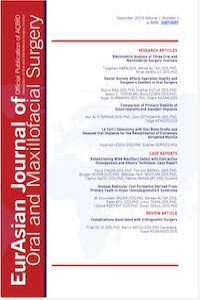Mandible-first sequence approach in bimaxillary orthognathic surgery using 3D printed surgical templates for facial asymmetry
Mandible-first sequence approach in bimaxillary orthognathic surgery using 3D printed surgical templates for facial asymmetry
Mandible-first, virtual planning, orthognathic surgery,
___
- 1. Mandible-first sequence in bimaxillary orthognathic surgery: a systematic review A. M. Borba, A. H. Borges, B. A. Venturi, M. G. Naclrio-Homem, M. Miloro: Mandible-first sequence in bimaxillary orthognathic surgery: a systematic review. Int. J. Oral Maxillofac. Surg. 2016; 45: 472–475.
- 2. Gil JN, Claus JD, Manfro R, Lima Jr SM. Predictability of maxillary repositioning during bimaxillary surgery: accuracy of a new technique. Int J Oral Maxillofac Surg 2007;36:296–300.
- 3. Perez D, Ellis 3rd E. Sequencing bimaxillary surgery: mandible first. J Oral Maxillofac Surg 2011;69:2217–24.
- Başlangıç: 2020
- Yayıncı: Ağız ve Çene Yüz Cerrahisi Birliği Derneği
Cansu Gül KOCA, Bengisu YILDIRIM, Muhammed Fatih ÇİÇEK
Primary Intraosseous Squamous Cell Carcinoma Coexisting with a Radicular Cyst: Case Report
Merve ARICI, Okan DURAN, Orçun TOPTAŞ, Çetin BORAN
Diagnostic Handicap: RHABDOMYOSARCOMA
Tolga BAYAR, Ebru Deniz KARSLI, Betül TAŞ ÖZYURTSEVEN, Metin GÜNGÖRMÜŞ
Dentigerous Cyst Associated with Ectopic Canine of the Maxilla: A Case Report
Rıdvan GÜLER, Bekir İLYAS, Serkan AĞAÇAYAK
Cihan VAROL, Yavuz FINDIK, Doç. Dr. Timuçin BAYKUL, Gülperi KOÇER, Mehmet Fatih ŞENTÜRK, Tayfun YAZICI, Mustafa Yasin YETER
Conservative Management of Large Dentigerous Cysts in Children
Ayşe ÖZCAN KÜÇÜK, Mahmut KOPARAL, Aydın KESKİNRÜZGAR
Maxillary Midpalatal Sagittal Fracture: A Case Report
Patient-Fitted Total Temporomandibular Joint Prosthesis: A Case Series
Seçil ÇUBUK, Palin ÇİFTÇİOĞLU, Burak BAYRAM
Assessment of the Level of Knowledge and Awareness of Dentists About Antibiotic Prophylaxis
Selen ONAT, Senanur DURUAY, Alptuğ KENDİRCİ, Serhat POLAT, Nur ALTIPARMAK
